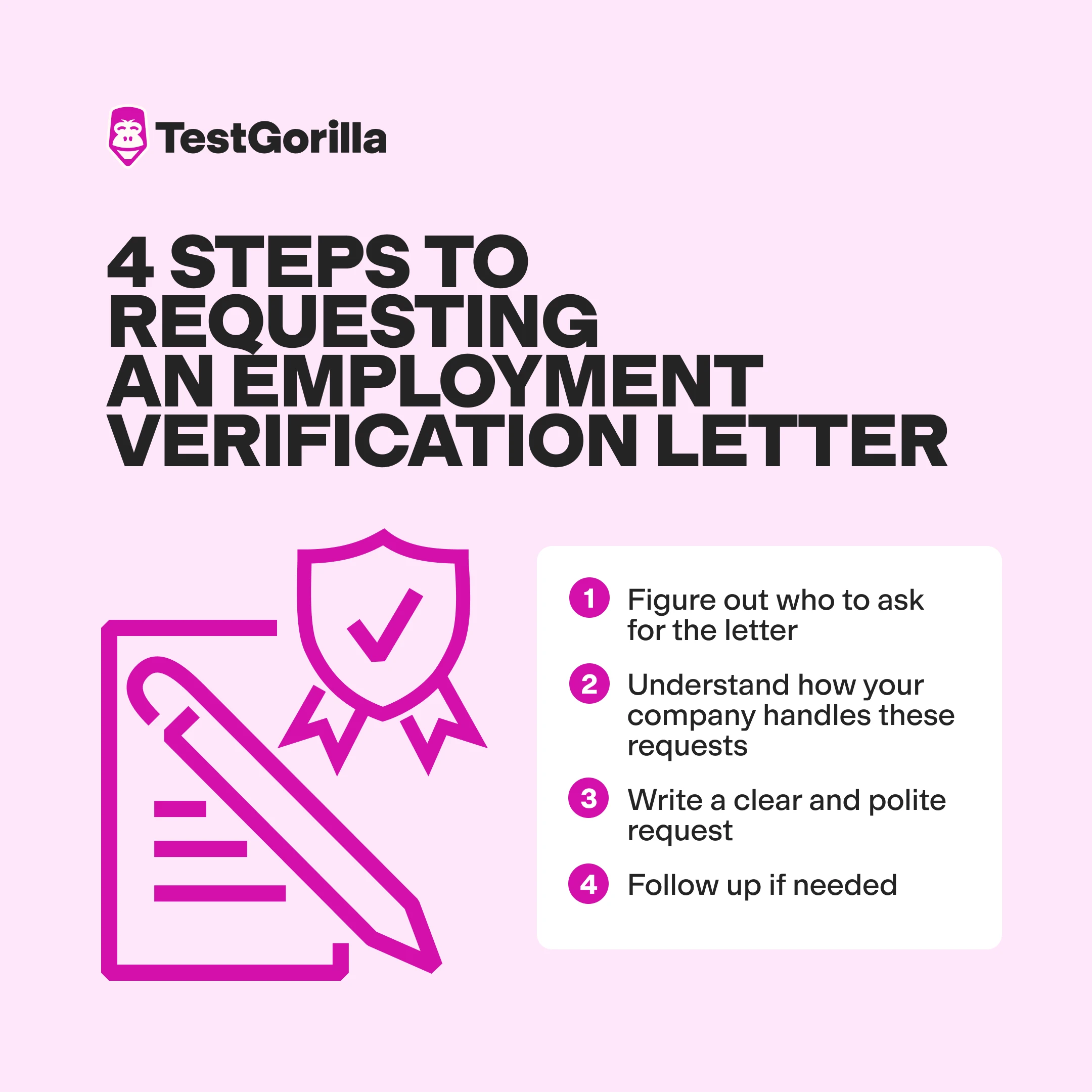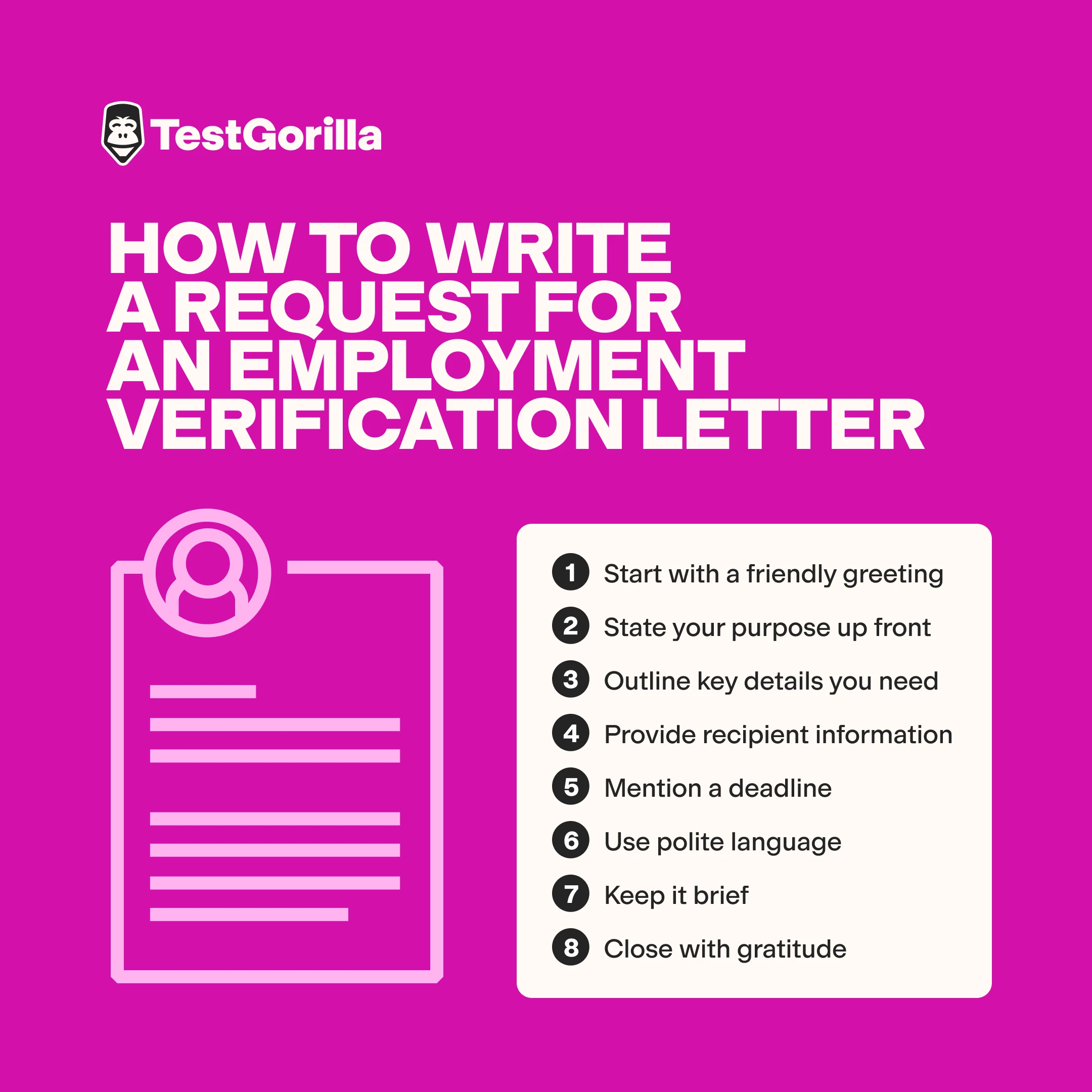Asking for an employment verification letter can feel a little nerve-wracking, but it’s a normal request – no need to stress or put it off. The process is also more straightforward than you might think.
This guide outlines four easy steps for requesting an employee verification letter. Keep reading, and you’ll be able to do it in no time!
Key takeaways
Find the right contact and process. Figure out who handles employment verification and follow any required forms or procedures.
Use company resources. Check your handbook or HR portal or ask coworkers to understand how requests are handled.
Be clear and professional. Include the purpose, required information, recipient details, and deadline in your request to avoid delays.
Follow up. If you don’t receive a response within a reasonable time, send a polite follow-up email.
What is an employment verification letter?
An employment verification letter is a document from your employer confirming basic details about your job, such as your title, length of employment, and sometimes salary.
You might need an employment verification letter for things like getting a mortgage, renting a place, applying for a visa, or qualifying for a loan. Essentially, it’s proof that you’re employed and earning an income, which helps others see that you’re reliable. Having this letter ready can make these processes smoother and less stressful.
4 steps to requesting an employment verification letter
Follow these steps to get an employment verification letter:
1. Figure out who to ask for the letter
Usually, this will be someone in HR if your company has an HR department. If not, it might be your manager or whoever handles payroll. Knowing the right person to contact saves you time and gets your request to the right place. Here are some ways to find out this information:
Check your employee handbook or portal. Many companies outline the process for requesting employment verification letters in their employee resources, like a handbook or intranet. Look for anything related to HR services or document requests.
Ask a colleague. Reach out to a coworker who’s been around longer or might have requested an employment verification letter before. They can point you in the right direction.
Contact HR directly. If you have a general HR email or phone number, reach out and ask who handles employment verification letters. They’ll guide you to the right person.
Ask your manager. If all else fails, your manager can let you know who to contact.
2. Understand how your company handles these requests
Next, find out how your company usually handles employment verification letter requests. Knowing the proper process will save you time and keep things simple.
Here’s what you can do at this stage:
Look for forms or templates. Check if your company has a standard form or template for employment verification requests. These might be on an HR portal, in a shared drive, or even in the employee handbook. If they exist, they’ll give you a clear idea of what information you’ll need to provide.
Ask about policies. When you contact the person who handles these requests, ask if there are any specific policies or procedures in place. For example, some companies require written requests, while others might need your consent before releasing your details.
Find out turnaround times. Ask HR or a coworker who’s done this before how long it usually takes to process an employment verification request. Some companies might handle it quickly, while others may need a few business days to prepare the letter.
Check for automation or tools. Larger companies may use automated systems or external services for employment verification. If this is the case, find out if you need to log in to a system or fill out a request online.
Learn if fees are involved. In rare cases, companies may charge a small fee for processing certain types of verification letters (like those with salary details). Ask if there are any costs upfront to avoid surprises.
3. Write a clear and polite request
When you’re ready to ask for the letter, make sure you:
Start with a friendly greeting. Address the recipient by name if you know it (e.g., “Hi [Name]”) to set a friendly tone.
State your purpose up front. Begin by explaining why you’re reaching out (e.g., “I’m writing to request an employment verification letter for [specific purpose].”).
Outline key details you need. List exactly what needs to be in the letter (e.g., job title, employment dates, salary) to save time and prevent back-and-forth questions.
Provide recipient information. Share the full name, address, or contact details of the person or organization receiving the letter.
Mention a deadline. Politely specify when you need the letter (e.g., “If possible, I’d appreciate having it by [date].”).
Use polite language: Include phrases like “I’d appreciate it if,” “Thank you for your help,” and “Let me know if you need anything else.”
Keep it brief. Avoid overloading your message with unnecessary details. Stick to the essentials to keep it clear and easy to read.
Close with gratitude. End your email by thanking the recipient for their time and assistance, leaving a positive impression.
Don’t forget: Send your request as soon as possible before your deadline. You want to give the person who handles these requests enough time to prepare your employment verification letter, which may take a while, depending on the turnaround time.
Template: Employment verification letter request
You can customize the following template to fit your needs when requesting an employee verification letter via email:
Subject: Request for Employment Verification Letter
Hi [HR Rep’s Name],
I’m reaching out to ask for an employment verification letter for [reason, like a mortgage application]. The individual requesting the letter needs the following details:
My job title
Dates I worked at [Company Name]
My current salary
Please address the letter to:
[Recipient’s Name] [Company/Organization Name] [Address]
They’d prefer to receive the letter via [method, such as email at recipient@example.com or fax at (123) 456-7890]. Please could you send it by [deadline]?
Thank you for your assistance. Please let me know if you need any more information from me.
Best, [Your Name] [Your contact info]
4. Follow up if needed
If you don’t hear back after a few days, send a quick and polite follow-up email. Here’s what to remember:
Wait a reasonable amount of time. Give the recipient enough time to process your request before following up. Usually, waiting 3-5 business days is appropriate unless you’re working with a tight deadline.
Keep it polite and friendly. Start your follow-up with a warm tone. For example, “Hi [Name], I hope you’re doing well” sets a friendly and non-intimidating mood.
Reference your original request. Briefly remind them about your earlier request to avoid confusion.
Offer to help or provide more information. Show you’re willing to make their job easier.
Reiterate your timeline (if needed): Politely mention your deadline again, if applicable.
Keep it short. One or two short paragraphs are plenty.
Thank them for their time. Always close with a show of appreciation.
Don’t forget: Follow up through the right channel. If your initial request was via email, stick to email for your follow-up. If it was through a system or form, check that before reaching out again.
Template: Follow-up on employment verification letter request
Below is an example of a follow-up on an employment verification letter request sent via email.
Subject: Follow-Up on Employment Verification Letter Request
Hi [HR Rep’s Name],
I hope you’re doing well. I wanted to check in on the employment verification letter I requested on [date]. Please let me know if you need any additional details from me to complete it.
If possible, I’d appreciate having the letter by [date], as it’s needed for [reason]. Thank you so much for your help.
Best regards, [Your Full Name] [Your Contact Info, if needed]
The best insights on HR and recruitment, delivered to your inbox.
Biweekly updates. No spam. Unsubscribe any time.
Confidently request your employment verification letter
Asking for an employment verification letter doesn’t have to be overwhelming. You can make it quick and stress-free by following the steps in this guide: finding the right contact, understanding your company’s process, writing a clear request, and following up if needed. Whether it’s for a mortgage, rental, visa, or loan, this process keeps things simple and gets you what you need without the hassle.
TestGorilla’s here to help you tackle workplace challenges like this and more. Need career tips? Check out our job seeker hub for advice and resources. Looking to sharpen your skills? Dive into our assessment guides to learn all about skills-based hiring. Whatever your goals, TestGorilla’s got your back.
FAQs
What is the difference between an employment verification letter and a confirmation letter?
An employment verification letter is used to confirm details about your job – e.g., your title, employment length, and sometimes salary – usually for things like loans, visas, or rentals.
A confirmation letter is more internal and is sent by your employer to confirm you’ve been hired, started a job, or completed probation.
What is another name for an employment verification letter?
An employment verification letter is also called a proof of employment letter or income verification letter.
Related posts
You've scrolled this far
Why not try TestGorilla for free, and see what happens when you put skills first.
















